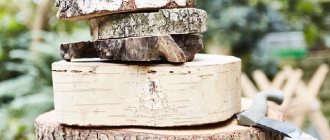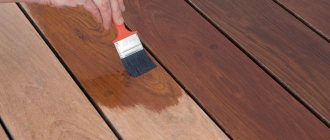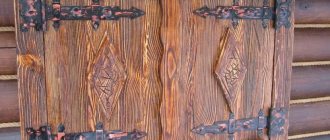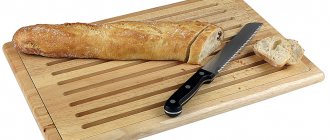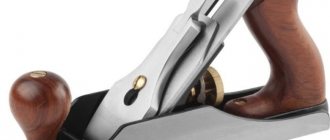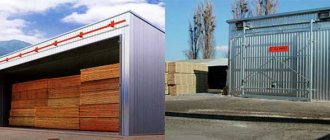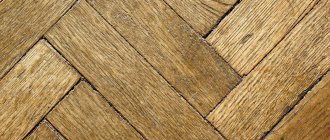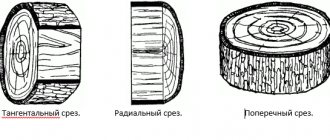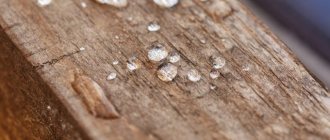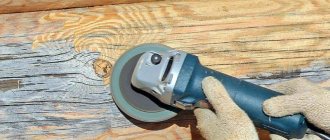Wood is ideal for constructing house walls, making furniture, decorative panels, toys and other products. This environmentally friendly material has an attractive appearance, low thermal conductivity and breathability.
Along with the advantages, wooden products have several disadvantages. Untreated wood can become covered with rot, mold, and microscopic cracks after just a few years of use.
To prevent the negative influence of the external environment, it is necessary to treat the material with antiseptics and other impregnations. Paints and varnishes will help protect wooden products for many years.
What is the choice of paint based on?
Painting wooden products should begin with the choice of dye. This procedure must be approached with special responsibility, because a low-quality composition will quickly fade, lose its original appearance, and will not be able to perform protective functions. When choosing paint, you need to pay attention to the color, raw material composition and purpose of the solution.
It is also necessary to take into account the most important factors:
- the type of wood that was used to make the house or other wooden structure;
- operating conditions of the product (temperature, humidity conditions, mechanical load);
- the presence or absence of an old layer of paint, the possibility of combining the coating with other paints and varnishes.
When choosing a pigment dye for painting wood, you need to ask the seller about the color of the film after application to the base. Impregnations can be transparent or covering. The latter solutions better protect the material, but cover the texture of the product.
The longer the strokes, the smoother the coating
If you have the option, position your pieces so that you apply all of the product you've got on your brush in one long, sustained stroke. This method allows you to avoid traces of overlap. If, after drying, unevenness still appears on the coating, sand the surface before applying the next coating.
Odorless paints
It is advisable to paint residential premises with quick-drying, odorless compounds. Residents spend a lot of time here, so the finishing solution should consist of environmentally friendly raw materials and not emit harmful fumes. Painting of furniture, decorative elements and other wooden products that are constantly located inside the house should also be carried out with water-based compositions that are safe for health.
Acrylic
This is the most modern type of paint. Acrylic compositions are highly expensive, they are made from environmentally friendly raw materials, and when applied they form an elastic film.
The pigment solvent in acrylic paints is water, so they do not emit harmful substances into the atmosphere. The high price of the material in question is justified by improved technical characteristics. The film is resistant to moisture, sudden temperature changes and ultraviolet radiation. Despite the frost resistance of the coating, the finished paint should not be stored at subzero temperatures.
Acrylic paint for wood is considered one of the highest quality materials. The coating retains its structure and color for 8 years.
Application of paint and varnish products to the prepared base can be carried out in various ways: with a paint brush, roller or spray gun. The solution penetrates deeply into the wood structure and dries quickly. The starting composition mixes well with various pigments, which allows you to obtain a coating of the desired shade. The acrylate composition protects wooden products from moisture while still being breathable.
Latex
Many consumers believe that a better effect can be achieved by coating wooden products with oil paint, but this solution has a characteristic odor, so it is better to use it for painting the facade of a residential building or in outbuildings. Instead of oil paints, you can use water-based latex paints, which will create the same effect as oil paints. The difference between latex paint and acrylic paint is the presence of rubber substances in the composition, which add elasticity to the dried surface.
The latex solution penetrates deeply into the wood structure, does not form streaks when applied, and creates a water-permeable layer on the surface. Despite the presence of water in the composition, dirt on the latex surface can be cleaned with a damp sponge.
The main advantage of the dye in question is the ability to breathe. This means that wooden walls painted with latex paint will allow water vapor to pass through the structure of the material well. A favorable microclimate is established in the house. The main disadvantage of the composition is the possibility of cracks appearing on the surface under the influence of negative temperatures, so the solution is recommended for use inside heated rooms.
Polyvinyl acetate (PVA)
Polyvinyl acetate compounds are considered in demand among consumers due to their low cost. This solution is used for interior decoration of walls and ceilings, consists of natural materials, and can be applied to wood bases, plaster or cardboard. The base solution can be diluted with any color, which allows you to obtain the desired color. After applying the composition, the user receives a beautiful matte or glossy surface. Another advantage of polyvinyl acetate paint is its rapid drying.
The disadvantages include the inability to paint metal products and the destruction of the coating under the influence of moisture. Therefore, the paint is not suitable for facade work; it cannot be used in wet areas.
The consumption of the composition depends on its color. To cover 1 m2 of usable area you need 250 grams of light-colored dye or 150 grams of a dark-colored substance. This is due to the fact that the first composition must be applied in two layers.
Wood putty. How to prepare the mixture with your own hands?
Making the mixture at home: ingredients.
An important property of the finishing composition is its strength and elasticity. Therefore, when mixing ingredients, it is necessary to add those substances that can give the mass the required qualities. There are three simple recipes that involve the use of readily available materials. They can be found in stores. A solution mixed by yourself will cost less than factory mixtures.
- If the wooden surface being treated is not very damaged and has only small cracks, you can use the simplest plastic mass of PVA glue, wood shavings and chalk. All ingredients are mixed so that the resulting solution has the texture of thick sour cream or paste. This putty is easy to prepare, but has one inconvenience in use: it takes a long time to dry. The presence of PVA glue prolongs the hardening process.
- A slightly more complicated composition allows you to repair larger and more noticeable surface defects. To prepare it, water-soluble varnish is added to the above materials. The mixture hardens much faster, but does not lose its strength characteristics. It is better to prepare the finishing mixture in the evening. In this case, the wood sawdust and shavings will soften better.
- The most labor-intensive to prepare, but the closest in quality to the factory composition, is made using oils and gelatin. First, highly crushed pumice (30 g) is mixed with turpentine oil (60 g), and linseed oil (280 g) is added to this. When the composition becomes homogeneous, 290 g of water, 12 g of borax, 20 g of white gelatin, 20 g of casein and 18 g of ammonia (18%) are added to it. The resulting mixture is placed in a water bath heated to 90 degrees. Stirring constantly, achieve a paste-like consistency. You can putty with this solution after it has cooled to 50 degrees. It is advisable to complete the work before the putty has completely cooled. You cannot reheat it again, as this will ruin its properties.
How to make putty mixture at home.
Oil paints
Oil-based paints and varnishes are gradually losing their popularity.
Such compositions are produced in a small assortment, which is associated with several disadvantages:
- long time for the solution to dry (the film gains strength within a day from the moment of application);
- the paint emits an unpleasant odor;
- high probability of leaks;
- does not combine well with other paintwork materials;
- toxicity;
- insufficient wear resistance and resistance to fading.
When painting wooden products with oil, it is necessary to thoroughly clean the base, because such a composition quickly peels off from the untreated surface. The advantages of using this coating material are considered to be low consumption and good penetrating ability of the solution.
Grinding
Products made of wood are sanded. An exception may be items that contain wood carvings. Sanding is usually done with sandpaper. It is made with different grain sizes, from coarse to “zero”.
Buy sanding materials for wood at a good price
Sanding should only be done along the grain to avoid further damage to the wood. Start with coarse-grained or medium-grained sandpaper. Grinding is done using blocks or blocks, with the help of which the sandpaper is pressed against the surface being treated. It is necessary to gradually move from coarse to fine sanding paper.
Alkyd
Alkyd dyes appeared on the construction market earlier than their acrylic counterparts. When dry, such compositions form a translucent water-repellent film on a wooden product.
The alkyd paint and varnish material dries quickly and does not have time to penetrate deep into the wood, which ultimately leads to a decrease in the durability of the protective coating. The solution is suitable for painting those wooden structures that suffer from moisture. These are door leaves, window frames and thresholds. Alkyd paint has high frost resistance; the coating can withstand temperatures down to -30 degrees.
Alkyd dyes must be applied to a previously prepared, dry surface. If the solution is applied to a wet base, roughness and bubbles will appear on the film. The drying of the layer continues for 8-12 hours.
How to carry out the work correctly
Once you have chosen a specific option, you can get to work. Instructions for applying the composition yourself are as follows:
- Before covering the lining inside the house, you need to stock up on the required tools. You can apply paint or impregnation with a brush, with a roller, or with a spray gun. You will also need a brush to clean the surface, a ladder to reach the top; if you are painting the ceiling, it is better to take a table;
It is better to choose brushes with thick, long bristles.
- Next you need to prepare the surface. To do this, you need to clean it from dust and debris. If there are stains on the wood, they should be removed. It is unacceptable to work on wet substrates; if the material has not dried completely, then painting cannot be started;
- Covering the lining with the composition is done in different ways. If you do the bulk of the work with a roller, then the seams are painted over with a brush afterwards. If you work with a brush from start to finish, then you can go in order. The composition must be distributed in an even layer, the formation of smudges is not allowed, for this reason it is better to paint from top to bottom, then all the flaws will be removed;
A flat surface is painted with a roller, the seams are finished with a brush
If you work with a spray gun, do not forget to stock up on protective equipment in advance: goggles, a respirator and a suit. During operation, a lot of small splashes are generated, and it is undesirable to inhale them.
It is necessary to work with the sprayer only with protective equipment
- In order for the coloring quality to be as good as possible, you need to apply at least 2, or even 3 layers. Some, before covering the lining with paint or varnish, impregnate it with an antiseptic. But even in this case, the decorative coating is applied twice, this allows you to achieve a rich color and durability of the coating.
The question is often asked, how to renew varnished lining? There are two options: if the surface condition is good, then you can go over the layer with fine sandpaper and apply a fresh coat of varnish. If the lining is darkened or damaged, then it is better to repaint it; to do this, use a composition on the same base, then it will fit perfectly.
Paint can be applied over varnish, after removing the shine with sandpaper
Polyurethane
Despite their high cost, polyurethane compounds have a lot of positive characteristics; they are used to protect wood, metal, stone and concrete, and can be used for painting smooth and loose surfaces. The material consists of environmentally friendly components. Only the solvent contained in the paint can cause harm to human health, but the hazardous substances completely evaporate after the film dries.
Polyurethane dyes form a durable, externally resistant, plastic coating. What is the cost of paint for flexible skirting boards? It does not collapse after deformation of the product. Polyurethane materials are suitable for painting wooden and concrete floors.
Why coverage and its purposes?
The unique texture of wood allows designers to create a “fairy tale” out of wood!
Beautiful oak tables, rattan furniture, larch parquet, bamboo wallpaper, solid wood kitchens and much more - all this wood needs a coating.
Many readers can correct us - bamboo is a grass, but we can tell them that it is processed with the same components as wood.
Wood processing is a separate industry in which many people work, inventing new coatings that can preserve such properties of wood for a very long time as:
- Reliability.
- Integrity.
- Color.
- Texture.
The main task before coating is not just to “cover up” the wood, but to emphasize and highlight its beauty while hiding possible flaws and all this at minimal cost, since the cost of varnishes and the like is quite high.
Epoxy
Such dyes can be powder, aerosol and two-component. The latter solutions consist of a hardener and resin. For painting wooden products, compositions based on cold-hardening epoxy resin are used. Under standard conditions at room temperature and normal air humidity, they harden within a day after application.
The main advantages of epoxy paints are:
- high strength and durability of the coating;
- waterproof;
- resistance to mechanical stress;
- good adhesion to any surface;
- wide selection of colors and shades.
Epoxy paints are used for painting floors and walls, household appliances, heating radiators, wooden garden figurines, and cars. The cost depends on the type of composition and its technical characteristics.
Lucky
This group of products allows you to create a durable layer on wood that protects the material from moisture. In addition, using varnish you can give the surface the desired shade, or you can use colorless options.
Let's figure out what types of compositions there are:
- Oil-based solutions create a durable protective layer that has good abrasion resistance. They can be used to treat any indoor surface. This option is characterized by low cost and a fairly large assortment of colors;
Oil compositions give the lining a rich color
- If you are thinking about how to cover the lining on the loggia, then pay attention to alkyd varnishes. They adhere very well to the material, give it shine and an even structure and protect it well from moisture;
Alkyd compounds are very popular
- The most environmentally friendly coating for lining inside the house is acrylic-based varnish. They are absolutely safe, odorless and adhere well to wood. An additional advantage can be considered low cost, and the main disadvantage is low abrasion resistance. For this reason, you should not use this composition on surfaces that are frequently touched;
Acrylic compositions are well suited for lining in residential areas
- For those who are deciding how to cover the outside of the lining, it is best to pay attention to polyurethane-based compounds. They have exceptional strength and wear resistance and create a reliable protective layer on the surface. They can also be used inside where you need to give the surface strength and protect it from wear.
Polyurethane compounds are the most reliable
Can car paint be used on wood?
Car paints are supplied to hardware stores in spray cans. The paintwork material consists of a pigment dye, a binder and a solvent. These are reliable, high-quality, durable compounds. The advantages of this composition are strength, density and resistance to mechanical damage. The only drawback of the paint is its high cost.
Car paint can be used to coat decorative wood products, but it is better to use a cheap alternative, such as silicone paint. Before painting, you need to sand the surface and apply a layer of primer.
Rules for applying putty
The best way to putty wood products with your own hands is to use a rubber spatula. This tool is quite elastic and thin. Thanks to the flexibility of the rubber, it is possible to thoroughly cover all the potholes and chips of the wood with a spatula. After drying, the mixture holds firmly in the grooves. Over time, the putty deforms along with the surface and does not come out of cracks.
In addition to the spatula, there is another tool - a sprayer. In order for the solution applied with this device to reliably hide defects, when mixing the ingredients it is necessary to achieve a paste-like consistency of the putty. Otherwise, the sprayer will become clogged with a thick and quickly hardening mixture, after which it will be hopelessly damaged.
Distributing the mixture over the wood.
The putty must be applied quickly but carefully. Typically, a thicker solution is used to seal isolated defects, while a dough-like solution can be used to putty the entire surface.
Before processing, the wood must be primed. This procedure helps subsequently apply the finishing coat evenly and efficiently. In addition, the soil penetrates deep into the wood, protecting it from moisture penetration. Applying a primer allows you to reduce the amount of finishing solution used by reducing the moisture absorption of the wooden surface.
For better adhesion, the primer is applied in 2-3 layers at a room temperature of at least 5 degrees. Between applying layers, it is necessary to wait some time for the soil to absorb and dry. It’s not difficult to do priming yourself, the main thing is to follow the manufacturer’s instructions.
Drying time
The drying period for any paint is indicated by the manufacturer on the product packaging, but this is only an approximate time.
The period is determined by various influencing factors:
- type of base. It has been noticed that paint dries faster on a porous wooden surface than on a smooth one;
- temperature indicators in the room. The higher the temperature, the faster the polymerization of the composition will occur;
- air humidity. As this indicator decreases, the drying period of the paint accelerates;
- circulation of air masses in the room. Hardening of the paint occurs better with active ventilation of the living room.
Nitro enamels and wax-based protective coatings dry the fastest. Paint and varnish materials, which are supplied to hardware stores in spray cans, dry well.
Aerosols harden within 20 minutes after application to the surface. After just half an hour, the material can be coated with a second layer of dye. Thus, the wooden product will be ready for use within an hour after painting.
Liquid nitro paints dry much slower. This coating is suitable for use after 5-10 hours.
An oil paint solution, which is applied to a porous base, dries in 3-4 hours, but certain conditions must facilitate this (room temperature and air humidity no more than 60%). The second layer of coating will harden only after 10 hours.
Water-based dyes take the longest to dry, this is due to the complex evaporation of water. The speed of the process depends on the temperature and humidity conditions indoors.
How to properly process the finishing layer?
Treatment of wooden surfaces at home.
Finished wood should not be left unfinished. To bring the result to mind, you need to level the top layer. With your own hands, this stage of finishing is performed in one of two ways: dry or wet. The choice depends on the quality and texture of the finishing coating.
If the putty was based on glue or oil, it is enough to process the dried solution with medium-grit sandpaper, cutting off any irregularities and roughness. Nitro putty is easier to sand after preliminary wetting. Water or turpentine is used as a moisturizer, and sanding is carried out with moisture-resistant sandpaper. By the way, you can also do nitro putty yourself. To prepare it, chalk and sawdust are mixed with nitro varnish.
You can treat a wooden surface yourself using homemade mixtures. If the work is carried out carefully and the rules for preparing and applying the finishing layer are followed, the product will serve its owner for a long time.
Finishing wooden decor with polyurethane or oil varnish?
What is the difference between polyurethane and oil-based varnish? The answer is simple: oil varnish contains resin and a solvent (oil or water). When you apply an oil-based varnish to wood, the solvent evaporates, leaving only the resin. Oil varnish can contain one of several types of resin. One of them is polyurethane resin. The advantage of polyurethane varnish is that it is stronger (feels like a plastic coating) than other types of varnish. The disadvantage is that when applied in a thick layer, it can become cloudy and more difficult to sand.
Use these tips if you need to refinish wood decor. They have been tested by time and the experience of professionals!
Subscribe to our newsletter so you don't miss the most interesting ideas! Just enter your e-mail in the form below
